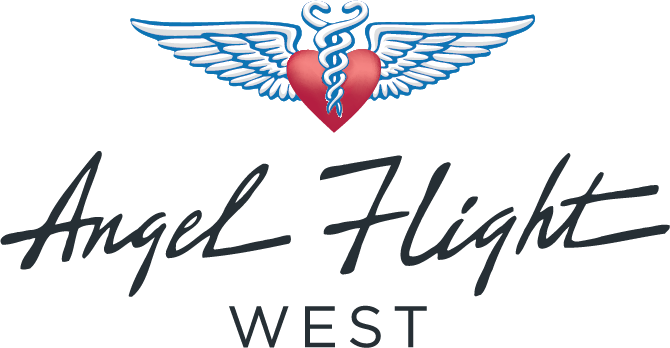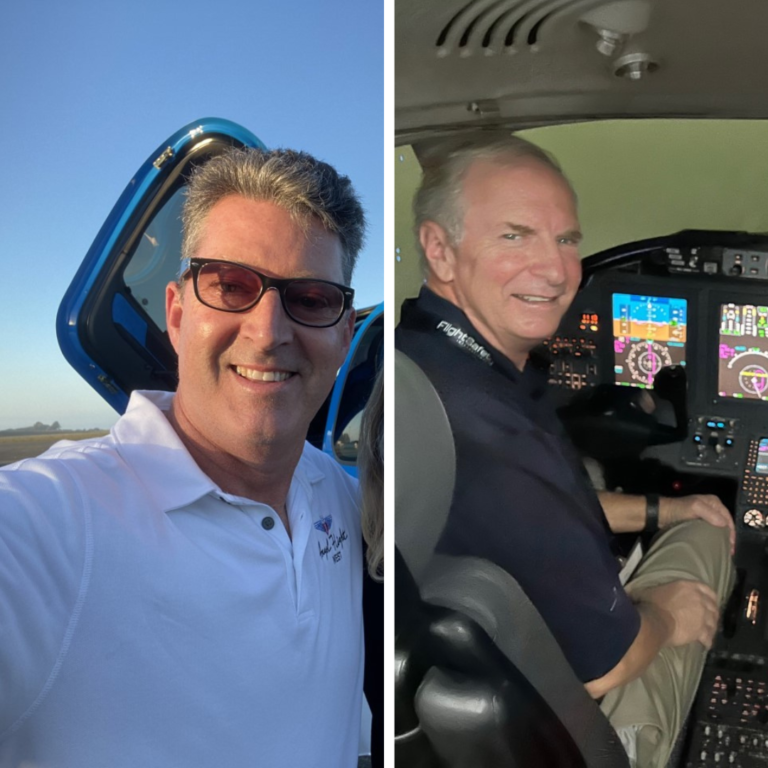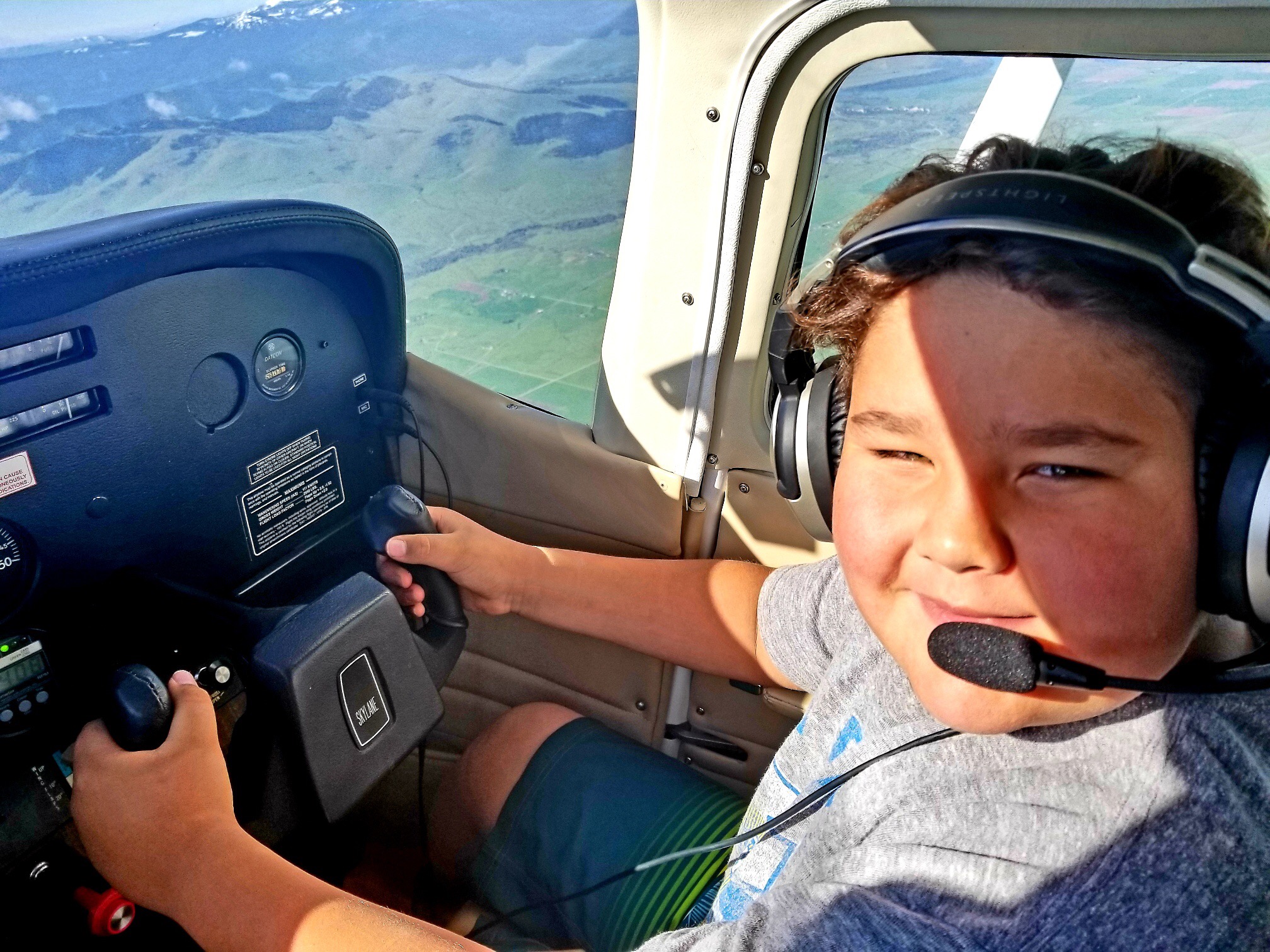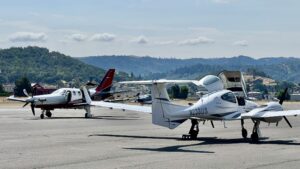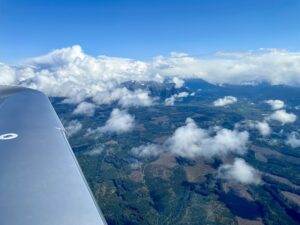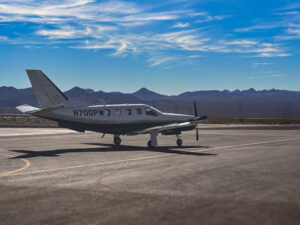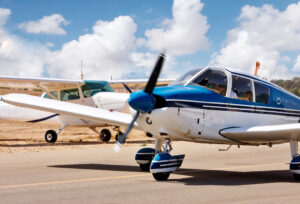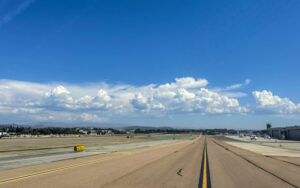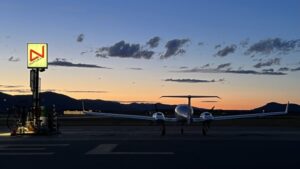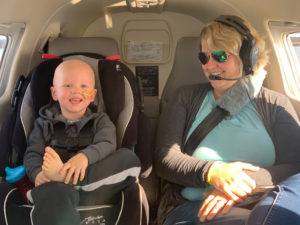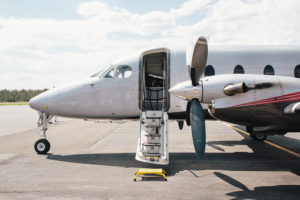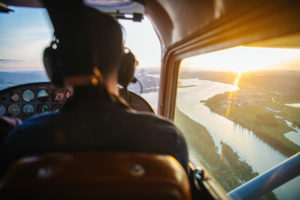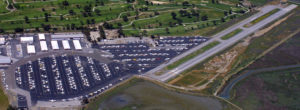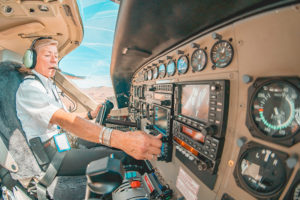Angel Flight West Command Pilots provide a great service for their passengers. They volunteer to provide transportation because they want to help others. Along with the desire to help comes the responsibility to ensure a safe trip. Angel Flight West wants all Command Pilots to keep safety at the forefront as they plan and execute their missions. With that goal, this section covers some of the key safety aspects to be considered when flying AFW missions.
Safe missions start with a pilot’s expectations or lack of expectations. With that in mind, no pilot is expected to:
- Accept any particular mission
- Fly or continue a mission in the presence of any doubt about completing it successfully
- Compromise safety in any way in order to complete a mission
Canceling a mission is considered a demonstration of good judgment and will never be criticized. If these three tenets are kept in mind, then a pilot can expect to have an enjoyable time participating in Angel Flight West Missions.
Passenger Safety and Comfort
Angel Flight pilots often carry neophyte or low time General Aviation passengers. These passengers may have concerns and fears and need some knowledge and personal management to ensure their comfort and safety. To ensure the passenger’s safety and comfort, the pilot should:
- Introduce general aviation to neophyte passengers. The time spent providing a general explanation about flying to a passenger while doing an abbreviated walk around will often assuage a passenger’s concerns and fears. One media induced misconception from both television and movies is that if the engine was to stop; an aircraft would immediately go into an almost uncontrollable dive. A short light hearted explanation that an airplane operating without an engine is simply a short winged glider can often abate that misconception and minimize any nervousness.
- Manage your passengers on the ramp. Passengers often don’t know about the dangers that airplanes present (like invisible spinning props). Escort your passengers to and from your aircraft, making certain that everyone is under control. This is especially important with children. Make certain that your engines are shut down prior to enplaning/deplaning, and manage your passengers so they remain clear of other aircraft, whether the engines are operating or not.
- Complete a thorough passenger briefing. FAR 91.519 requires that a pilot provide a thorough passenger briefing for all passengers on every flight. A good briefing includes explaining seat belt and shoulder harness operation, operation of entry doors and emergency exits, location and use of survival equipment, life jackets, and life vests, the use of oxygen masks, as well as what the passenger should and shouldn’t do during the flight. From an operational standpoint, the passengers should be briefed on how to use headsets (and where to place the mic), the intercom (if equipped), the pilot’s preferred hand signals, and so forth. Pilots should be prepared to communicate with passengers that are blind, deaf, or those who speak a language other than that which the pilot speaks. For deaf passengers, ensure a paper and pen are available.
- Seat belts on all passengers. Seat belts should be worn at all times. Young children and babies MUST be in appropriate children or baby seats and these seats should be attached to passenger seats and oriented correctly for the age of the child and type of seat. No child seat should ever be attached to a front seat.
- Sterile cockpit as required. Passengers should be told that from engine start through the climb to cruise altitude is considered a “sterile cockpit” time where the passengers should only speak to the pilot if there are personal problems or issues or to assist the pilot (e.g. pointing out other aircraft). The same “sterile cockpit” rule should apply from the pilot’s specified point on the descent to the destination through engine shut down. The pilot should explain to the passenger(s) how they should get the pilot’s attention if they do have a problem or issue, and should notify the passenger when it is appropriate to speak freely.
- Monitor weather conditions. The pilot should continue to monitor weather conditions throughout the flight, especially if weather conditions warrant. The pilot should use Flight Watch (122.0), an FSS, and/or onboard satellite weather. If there are any questions regarding the weather, the pilot should create an alternate strategy, which may include returning to the departure airport, diverting to an alternate, or holding for the weather to clear. If the weather makes a successful completion of the flight questionable, the pilot should discuss the weather and the options with the passenger and, together, agree to an alternative strategy. Remember, however, that the Pilot in Command has the final decision. A safe conclusion to any flight is the ultimate goal.
- Monitor fuel usage & requirements. During the flight, the pilot is expected to continually monitor fuel consumption and remaining fuel. This becomes even more important if there are weather or other issues that may require a diversion or holding.
- Use ATC/aircraft resources. The pilot should avail himself of ATC’s resources if and when there is an issue of safety. The passenger(s) can also be used as a resource where desirable. For example, asking the passenger to watch for other airplanes is always a good use of the passenger.
- Monitor your passenger’s condition. Being constantly aware of your passenger’s condition can mean a great difference in the success of a flight. If your passenger is uncomfortable for whatever reason, it is the pilot’s responsibility to initiate a response. Often that will mean nothing more that providing fresh air or changing to an altitude that is smoother. But if the passenger is physically uncomfortable, it might mean diverting to another airport or returning to the destination. In extreme cases where the passenger’s condition might be life threatening, it might require declaring an emergency and flying directly to an airport located near suitable medical facilities. If you encounter a questionable situation, declare an emergency and use the “Lifeguard” call sign.
The Eight Deadly Flying Sins
Studies done by the AOPA’s Air Safety Foundation and other organizations have identified a finite set of causative factors that lead to the majority of accidents with injuries and fatalities. The ASF’s 2007 Nall Report statistics state that pilots were the cause of 73.8% of all GA accidents and 79.1% of all fatal accidents. If a conscientious pilot avoids the following traps it minimizes the likelihood of an accident.
- Fuel Mismanagement. Fuel mismanagement constituted nearly 9% of all GA accidents. Whether it is running out of fuel or fuel starvation even though there is fuel onboard, this type of accident happens nearly twice a week and is almost always avoidable.
- Overloaded and/or Out of CG. General aviation aircraft are reasonably limited in terms of payload and CG. Each aircraft’s documents contain the aircraft’s official “weight and balance” paperwork so the pilot can ensure the aircraft as loaded is safe to fly. An overloaded aircraft doesn’t perform at POH performance values, the stall speed is higher than normal, and an aircraft that is out of CG can be uncontrollable.
- High Density Altitude Operations. All pilots should always be aware of the performance robbing effect of density altitude. Density altitude is an insidious danger because it doesn’t have to be particularly hot for it to have a major impact on an aircraft’s takeoff and climb performance, especially at heavy weights.
- Takeoffs and Landings Accidents. Although typically not deadly, landings and takeoffs are responsible for an inordinate number of accidents each year. According to the Nall Report, almost 57% of all accidents happen during takeoff or landing. Not surprisingly, a full 40% happened during landing. Wind and turbulence, unextended landing gear, loss of control, and midair collisions on final, are some of hazards of airport operations.
- Maneuvering Accidents. Maneuvering flight has been the number one cause of fatalities in general aviation. During the last ten years, more than one-quarter of all fatal accidents happened during maneuvering flight. Low altitude maneuvering accidents are usually fatal and often, but not exclusively, the result of a pilot operating an aircraft in marginal weather conditions.
- Continued VFR Flight into IMC Conditions. Almost always deadly, and not just the purview of VFR pilots, continued VFR flight into IMC conditions is usually 100% fatal to non-instrument rated pilots, and surprisingly enough, claims instrument rated pilots as well.
- Controlled Flight Into Terrain (CFIT). CFIT accidents are usually attributed to IFR operations, but CFIT accidents also happen during VFR operations, especially at night.
- Must Complete the Flight Mindset. Also referred to as get-home-itis, pilots of all ratings and hours have succumbed to the desire to complete the flight and ended their flights in a tragic way. AFW’s passengers and missions can encourage an unaware pilot to fall into this trap.
Angel Flight West’s Potential Risky Mindset
AFW pilots are subject to all of the Eight Deadly Sins listed above, but the one that may be most compelling to an ”angel flight” pilot is the last one, a pilot’s desire to complete a flight in the face of risk. After all, an AFW mission isn’t just a personal flight, it is a flight to help someone in need. The pressure to complete the flight might come from some of the following motives:
- Carrying an Unknown Person as Passenger. It is sometimes more difficult to disappoint a stranger than someone you know.
- Awareness of Passenger’s Personal Needs. As an “angel flight” pilot we want to help our passengers. The more we know about the person and their needs the more we want to make sure we deliver them to their destination.
- Signed up for the Mission. Pilots have a strong personal motivation to complete what they start. When a pilot signs up for a mission, it is their nature to complete the mission.
- Personal Obligations Afterward. If a pilot has personal obligations after a mission, there will be pressure to complete the mission.
- Proximity to the Destination. The closer the aircraft is to the destination, the greater the desire to complete the flight.
Accident Chain – What To Do In An Emergency
Many accidents are the result of a series of incidents, mistakes, or bad decisions; otherwise known as an accident chain. Often, all it takes to stop an accident is for one of the links in the chain to be broken. The best way to do that is to always make good decisions. But if there is a problem or issue, there are some things that can be done to mitigate the risk.
- With any problem or issue the pilot must fly the aircraft first.
- Use the aircraft’s emergency check lists if they are applicable to the emergency.
- Use ATC as well as your passengers to identify a landing site, provide directions, read a check list, find a frequency, whatever is necessary.
- If the problem warrants, the pilot should DECLARE AN EMERGENCY. That ensures you can do what you need to do without endangering other aircraft, and you will have 100% of ATC’s focus and assistance. Pilots are often reticent to declare, but every pilot needs to understand that when the situation warrants declaring an emergency shows sound decision making and good judgment.
- As difficult as it sounds, forcing yourself to remain calm and talking through the problem and solution can keep you from fixating.
- Finally, as the old saying goes, runway behind, fuel left on the ground, and altitude above are all worthless, so keep those in mind as you plan and fly any flight. Additional altitude can, for example, make an acceptable off-airport landing location accessible and additional fuel can take the stress out of a hold vs. divert decision.
Think, Act, and Fly Like a Professional
There are many reasons that the airlines and professional business pilots have better accident records that general aviation pilots. Some of their success has to do with the aircraft they fly and the ground support and resources that they have access to. Much of their success has to do with their professional attitudes and planning.
Professional pilots operate to more stringent rules than normal pilots. They often have regulatory minimums and other criteria that they set and follow as well. For example, they have mandated to them a very specific official rules in terms of fuel, weather, pilot rest, and so forth. But they may personally set higher instrument approach minimums depending upon their flight and instrument currency. While you can’t avail yourself of their company resources, you can follow their lead by:
- Set “Personal Minimums” for yourself. A tired, ill, or distracted pilot is prone to make mistakes. Be honest about you health, whether you are rested, whether you have personal/family issues, and so forth. Don’t fly if there is any question.
- Set Flight Minimums. Set en route and airport weather minimums below which you won’t fly. Verify your aircraft’s take-off and landing performance is suitable for the airports you plan to operate out of at the desired mission weight and then add a safety factor. Set personal instrument weather minimums that are appropriate for your instrument currency and abide by them. Set personal criteria for every phase of flight.
- Use Checklists. It is a given that professional pilots use checklists. Sometimes they are written, sometimes they are also committed to memory, and sometimes they are flows around a cockpit. It doesn’t matter which you use, each can be used for different things during a flight, what matters is that you consistently use some sort of check procedure.
- Communicate with the passenger. Good communication with the passenger is important, especially if there are issues with the weather, completing the flight, and so forth. But it is also important to keep the passenger informed regarding the state of the flight and the current ETA. As the Pilot in Command, you make the final decision, but if your passenger understands and agrees with your decision, the passenger will be more comfortable and you will be able to better focus on the remaining flight.
- Monitor Weather Conditions. Professional pilots recognize that weather will often be the gating factor in a successful flight. As a result, they monitor the weather to minimize any surprises and they make informed decisions earlier than pilots who aren’t as aware.
- Monitor Fuel Usage & Requirements. A pilot should always know how much fuel is remaining, how much is required to reach the destination, and how much to reach the alternate with a legal quantity of fuel remaining onboard. With that knowledge, the stress and cause of many general aviation accidents completely disappear.
- Use ATC/aircraft resources. Airline pilots usually have a copilot, often a flight engineer, and usually instant access to ground support resources through air-to-ground communications. As a general aviation pilot we rarely have any of the above. But we often have an autopilot, a passenger, and we can always count on ATC as a resource. Use them all to make the flight more professional.
Flight and Instrument Currency
By signing the Angel Flight West Pilot Affirmation Form, each Command Pilot agrees to abide by the FAA’s minimums currency requirements for the appropriate category of aircraft being flown on any AFW mission:
- Day VFR – Three takeoffs and landings within 90 days
- Night VFR – Three takeoffs and landings to a full stop within 90 days.
- Instrument Operations – Six instrument approaches, holding, and intercepting and tracking courses through the use of navigation systems in actual IMC or simulated IMC conditions within six months.
The question that must be asked and answered honestly is, are those currency minimums enough? Single pilot night and instrument operations are some of the most demanding operations in general aviation. Low or deteriorating weather conditions increase the requirement that a pilot be on his game. Crosswinds can be a challenge even when a pilot is current. Remember, proficiency is a product of more than just recent flight time. Personal health, rest, family and work situations, and so on all can affect a pilot’s concentration and focus.
Ask yourself whether your personal situation, currency, and proficiency not only meet the legal requirements but the common-sense requirement for safe operations for the conditions you may encounter. If there is any doubt, then set higher minimums for each type of operation.
Ongoing Study
All pilots benefit from ongoing learning and training. Angel Flight encourages all pilots to participate in the Wings Program and to avail themselves of the learning resources of the AOPA Safety Foundation and the FAA. URLs for both are
- AOPA Safety Foundation http://www.aopa.org/asf/
- FAA http://www.faasafety.gov
Scenario-Based Flight Review
AFW pilots should consider comprehensive Scenario Based Flight Reviews that take into account some of the factors that are inherent in ”angel flight” missions, such as:
- Small and large airport operations
- Flights into new or unusual environments (e.g. busy terminal areas, mountainous terrain, coastal airports, etc.)
- Risk assessment and decision making
- Weather operations specific to all possible mission areas (e.g. desert density altitude operations, mountainous terrain, local weather patterns, marine layer, etc.)
- Multi-leg flight planning and operations
- Diverting or returning to the departure airport
- IFR introduction and practice (for VFR Pilots)
- Instrument Currency and Competency (for IFR Rated Pilots)
By studying and reviewing these during Flight Reviews, a pilot will be better prepared for “angel flight” missions.
Safety Is Your Responsibility!
As an AFW Pilot, you will have the opportunity to fly missions in a variety of weather conditions, into and out of a variety of airports, and with a variety of passengers. The responsibility for a safe flight is yours alone. At the same time, AFW missions provide an opportunity for you to increase your decision making and piloting skills while you are helping others. Always remember Angel Flight West’s basic tenets:
No pilot is expected to:
- Accept any particular mission
- Fly or complete a mission in the presence of any doubt about completing it successfully
- Compromise safety in any way in order to complete a mission
- Canceling a mission is considered a demonstration of good judgment and will never be criticized.
